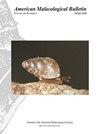Species Abundance, Spatial and Vertical Distributions, and Eye-Size Trends of Large Heteropods (Pterotracheidae and Carinariidae) in the Northern Gulf of Mexico
IF 0.4
4区 生物学
Q4 MARINE & FRESHWATER BIOLOGY
引用次数: 3
Abstract
Abstract: Heteropods are predatory planktonic gastropods that are important in pelagic ecosystems. However, distributions of large heteropod species are poorly known. Heteropod collections from two midwater sampling programs conducted after the 2010 Deepwater Horizon oil spill (DWHOS): the Offshore Nekton Sampling and Analysis Program (ONSAP) in 2011 and the Deep Pelagic Nekton Dynamics of the Gulf of Mexico (DEEPEND) in 2015-2018 were used for this study These programs collected over 3,495 heteropods in the two target families from 46 sampling stations in the northern Gulf of Mexico (GOM). The zone along the northeastern GOM continental slope had the greatest species richness and abundances. The family Pterotracheidae (Pterotrachea coronata (Forsskal 1775), Pterotrachea hippocampus(Philippi 1836) and Pterotrachea scutata (Gegenbaur 1855) was the most abundant and contained the largest specimens examined. Common carinariids included Carinaria lamarcki (Péron & Lesuer 1810) and Cardiapoda placenta (Lesson 1830). We found evidence of diel migration in P. coronata and P. scutata but not for C. lamarcki, C. placenta or P. hippocampus. We evaluated body and eye size at capture depth for each species. There was no evidence of eye size increasing relative to body size with depth among the five species and relative eye size is species-specific. However, it was observed that vertical migrators had a different eye-type than the non-migrators. We determined that pterotracheids have smaller eyes relative to their total body size than carinariids. The allometric pattern of eye growth differed in P. scutata from those of the other species which could indicate that a factor other than depth plays a part in heteropod eye development. This is the first comprehensive study of large heteropods in the northern GOM which provides an important baseline for continued study of this pelagic gastropod.墨西哥湾北部大型异足类(翼龙科和船底科)的物种丰度、空间和垂直分布以及眼睛大小趋势
摘要:异足类是浮游腹足类动物,在浮游生态系统中占有重要地位。然而,人们对大型杂多物种的分布知之甚少。本研究使用了2010年深水地平线漏油事件(DWHOS)后进行的两个中层水采样项目的异足类采集:2011年的近海Nekton采样和分析项目(ONSAP)和2015-2018年的墨西哥湾深海Nekton动力学项目(DEEPEND)墨西哥湾北部(GOM)。GOM大陆东北部斜坡带的物种丰富度和丰度最高。翼龙科(Pterotrachea coronata(Forsskal 1775)、海马翼龙(Philippi 1836)和盾翼龙(Gegenbaur 1855)是数量最多、标本最多的科。常见的隆突包括拉马基隆脊藻(Péron&Lesuer 1810)和Cardiapoda胎盘(1830课)。我们在P.coronata和P.scutata中发现了昼夜迁移的证据,但在C.lamarcki、C.胎盘或P.海马中没有发现。我们评估了每个物种在捕获深度下的身体和眼睛大小。在这五个物种中,没有证据表明眼睛大小相对于身体大小随着深度的增加而增加,相对眼睛大小是特定物种的。然而,据观察,垂直迁徙者的眼睛类型与非迁徙者不同。我们确定,相对于它们的总体型,翼鞘类动物的眼睛比隆脊类动物的小。盾叶藻眼生长的异速模式与其他物种不同,这可能表明深度以外的因素在异速眼发育中起作用。这是对GOM北部大型杂多动物的首次全面研究,为继续研究这种远洋腹足动物提供了重要的基线。
本文章由计算机程序翻译,如有差异,请以英文原文为准。
求助全文
约1分钟内获得全文
求助全文
来源期刊
CiteScore
1.00
自引率
40.00%
发文量
1
审稿时长
>12 weeks
期刊介绍:
The American Malacological Bulletin serves as an outlet for reporting notable contributions in malacological research. Manuscripts concerning any aspect of original, unpublished research,important short reports, and detailed reviews dealing with molluscs will be considered for publication. Recent issues have included AMS symposia, independent papers, research notes,and book reviews. All published research articles in this journal have undergone rigorous peer review, based on initial editor screening and anonymous reviewing by independent expertreferees. AMS symposium papers have undergone peer review by symposium organizer, symposium participants, and independent referees.

 求助内容:
求助内容: 应助结果提醒方式:
应助结果提醒方式:


